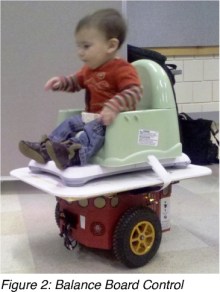Wii Balance Board Use #357: Making Disabled Babies Mobile
Four researchers at Ithaca College have addressed the problem of disabled infant mobility in a unique way. Unlike older disabled individuals, babies “lack the subtle grasp of grasping things” as Kotaku puts it. Things like the joysticks of electronic wheelchairs.
How do babies instinctively move, however? By leaning towards what they want. Well, you know what relatively cheap and common electronic device can tell where you are leaning? A Wii Balance Board.
But wait, we thought, childless idiots that we are; what’s the problem? If the baby is just sitting there it can’t get into trouble. Apparently the ability to explore their own surroundings can be kind of important to cognitive development. According to the study:
Independent mobility is crucial in the development of typical infants, as it allows them to acquire a broad range of skills in the cognitive, perceptual, emotional, and social domains. Typically developing children whose mobility has been restricted for even relatively short periods of time have been found to demonstrate apathetic behavior and depressed motivation. Children with physical disabilities and restricted mobility have been found to demonstrate increased dependence, frustration, depressed motivation, lack of curiosity, and a lack of confidence.
Several investigators have reported that children with physical disabilities may achieve significant developmental benefits from the use of powered mobility, including increased interaction with the environment and contact with others, self-initiated independent movement, positive affect, and communication.
Mobility options have been scarce, expensive, and ineffective for the youngest children. The study, Infants Control of a Robotic Mobility Device, aims to solve all of those problems.
The setup that they are now hoping to take to more scientific trials that their simple troubleshooting tests consists of a Pioneer 3 Robot, a child seat, a Wii Balance Board and a few other items (including a wireless joystick for manual adult override). And for a prototype, it only looks a little kludged together.
The little robot moves in the direction that the child leans, and, yes, the robot has anti-collision sonar.
Unfortunately the paper says nothing about the safety measures in place that will prevent an unstoppable robot baby army, but hopefully those concerns will be taken care of within the first few phases of clinical trials.
Unfortunately there is no video footage of their prototype in action, so we can only offer you this preview (skip to 1:15):
(Infants Control of a Robotic Mobility Device via Kotaku.)
Have a tip we should know? tips@themarysue.com
